

|
by Joseph Brennan. Copyright 2001, 2002. |
86 StPassenger service: May 1876 - about 1903.Existing abandoned portions: 2 platforms (on tracks in service). Touring: Metro North trains running between Grand Central Terminal and 125 St on the outer tracks. Look out the front window if possible. Hatches over the former entrance can be seen at street level. construction and operationThe railroad tunnel under Park Ave was built by the New York Central and Hudson River Railroad in 1872-1876. It replaced a railroad mainly at street level that was opened by the New-York and Harlaem Rail-Road (sic) up to Harlem station at 125 St in 1837. The New York and Harlem started as a local railroad, and its entire line in Manhattan was within the limits of city streets. The first railroad in the City and one of the first railroads in the country, the Harlem transformed itself with the times. It reached its farthest point, Chatham, 127 miles from 42 St, in 1852, and in the meantime the New Haven railroad began feeding trains from New England into the Harlem line at Woodlawn in 1848. After consolidating what are now the Hudson, Harlem, and New Haven lines into Grand Central Depot in 1871, the New York Central had to improve the two-track railroad running into it, which was now expected to carry the traffic of three main lines, 130 trains a day in 1872. The company undertook a reconstruction of the line called the Fourth Avenue Improvement to get the railroad off street grade and widen it to four tracks. From the station yard, a tunnel, a viaduct, and a cut would carry trains all the way to the Harlem River bridge. The City paid half the cost, for the sake of getting the trains off street level, which was expected to spur development of the east side. In return, the railroad was to operate frequent local trains stopping at a few stations in Manhattan. The tunnel runs for two miles from 56 St to 96 St. Parts of it are true tunnel with a masonry arch roof, and parts are "beam tunnel", masonry walls with a roof of iron beams. The center two tracks share one structure under the Park Ave mall, with originally large and small openings in the mall to vent the smoke from the steam engines. On each side of the central two-track structure is a single track tunnel with frequent openings across to the center tunnel. The three stations in the tunnel are short, for local trains of not more than four short cars. They had high platforms at car floor height, which was not common at the time, not even at the Grand Central Depot. The 150 foot long platforms at 59 St and 72 St are located on the outer sides of the tunnel, and the ticket office, waiting rooms, and toilets were at platform level. An eight-foot wide iron stairway, divided into up and down sides, led up to an eight by twelve foot wooden house on the sidewalk. The 172 foot long platforms at 86 St are located between the center pair of tracks and the side tracks. They are not island platforms. A four-foot thick stone wall separates them from the center pair of tracks, and is lined with brick on the platform side. There was no waiting room, but there was a wooden station house with the ticket office, located in the Park Ave mall, four steps down from the street. From there, passengers continued down east or west to a landing completely below street level, and turned at a right angle to continue down to the south end of the platform. The building is long gone, but the stairways still exist and were still visible as recently as the 1980's. More recently they have been covered with secure metal hatches. The reason for 86 St having a different plan is that the side tunnels needed to be located away from the center tunnel starting just on the north side of the station. From 92 St to 94 St, the center tunnel runs through the Mount Pleasant Tunnel opened in 1844, and the side tunnels had to be located far enough out to avoid compromising the old tunnel's side walls. Having one ticket office at 86 St is even an improvement over the two separate northbound and southbound stations at 59 St and 72 St. 86 St station opened on 15 May 1876, when the New York Central started a "rapid transit" service of local trains to Williams Bridge. The trains made all stops and ran about hourly, not at a clock interval, sixteen each way. The railroad credited air brakes with making it practical to run trains that stopped so frequently. It was a good service for its day, especially to points north of Harlem. The fare was 10 cents as far as Mott Haven (138 St) and 15 cents to Williams Bridge. The opening of the Third Ave El a block away in 1878 must have hurt ridership from 86 St to Grand Central, but the station was kept open. A surviving employee timetable from 1895 still shows many local trains stopping at 86 St. Within a few years more, however, the station was closed, and probably did not survive to see the electric trains inaugurated in 1906. Notably, the rapid transit timetable did not list stops at 59 St and 72 St. It is not clear whether they ever had regular train service. Below is the complete schedule of service to 86 St, 110 St, and Harlem at the start of rapid transit service, 15 May 1876. The rapids ran to Williams Bridge. A few additional Harlem Division trains stopped at Harlem as shown. No Hudson Division or New Haven railroad trains stopped at the three local stations. |
Inbound Harlem 0603 0653 0713 0737 0800 0833 0918 1000 1048 1148 1249 110 St 0606 0656 0716 0740 ---- 0836 0921 ---- 1051 1151 ---- 86 St 0609 0659 0719 0744 ---- 0839 0924 ---- 1054 1154 ---- Grand Central 0615 0705 0725 0750 0810 0845 0930 1010 1100 1200 1259 Harlem 1338 1438 1519 1638 1659 1723 1738 1752 1903 1944 2108 2320 110 St 1341 1441 ---- 1641 ---- 1726 1741 ---- 1906 ---- 2111 2323 86 St 1344 1444 ---- 1644 ---- 1729 1744 ---- 1909 ---- 2114 2325 Grand Central 1350 1450 1529 1650 1709 1735 1750 1802 1915 1954 2120 2330 Outbound Grand Central 0630 0715 0745 0810 0915 0940 1035 1130 1230 1330 1530 86 St 0636 0721 ---- 0816 ---- 0946 1041 ---- 1236 1336 1536 110 St 0639 0724 ---- 0819 ---- 0949 1044 ---- 1239 1339 1539 Harlem 0642 0727 0755 0822 0925 0952 1047 1140 1242 1342 1542 Grand Central 1605 1630 1715 1745 1815 1900 1945 2040 2215 2345 86 St 1611 1635 1721 1751 1821 ---- 1951 ---- 2221 2351 110 St 1614 1637 1724 1754 1824 ---- 1954 ---- 2224 2354 Harlem 1617 1640 1727 1757 1827 1910 1957 2050 2227 2357 |
|
|
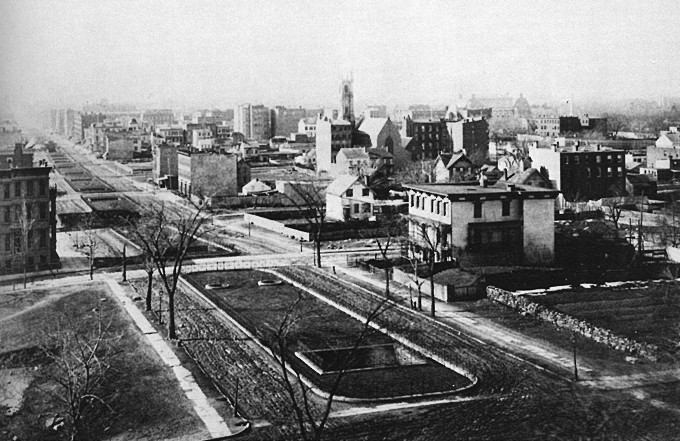
|
A view down Park Ave in the winter of 1882-1883 shows 86 St station in the distance. Photographer Peter Baab was standing on the roof of beer magnate George Ehret's house at 94 St, and 93 St is the first cross street at the bottom of the frame. The outline of the station house with the lower side portions can be seen. The tunnel has two ventilation openings in each block. Peter Baab, Museum of the City of New York collection, from Roger Whitehouse, New York Sunshine and Shadow, New York: Harper and Row, 1974. |
|
|
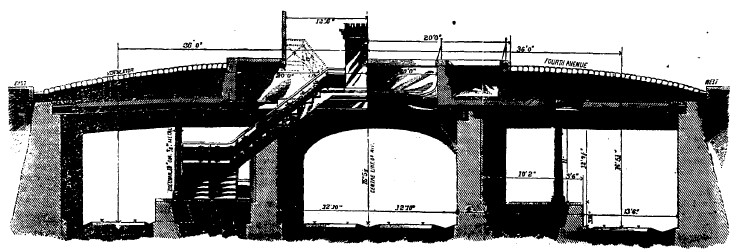
|
Scientific American published a nine-part series on the Fourth Ave Improvements from November 1874 to February 1875. Here is a cross section at 86 St station. The left side shows the south end with the station house, and the right side shows the simpler structure along the platform. Scientific American, February 13, 1875. |
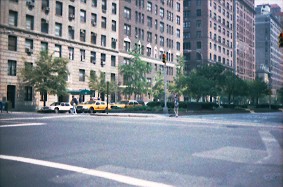
The site of the station can still be seen in the center mall of Park Ave. |
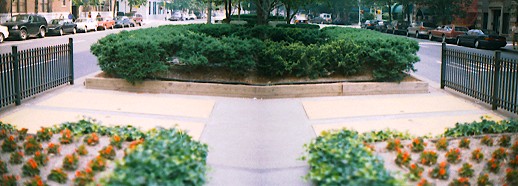
|
The hatches cover the stone steps that lead down to each platform. This area was inside the wooden station house. In the center of the hedge just beyond is an opening to the tunnel, with a crumbling brick edge and a steel grating of uncertain strength. It is of course over the center two track part of the tunnel. Trains can be seen racing by. If you go along the edge of the mall on the left and look down into the space, allowing your eyes to adjust, you should be able to see a short ladder at the tunnel floor, and then realize that it runs from trackside up to the northbound platform, of which a very small part is actually visible in the gloom. There must be an opening across to the side tracks at just that point, where the station entrance was. Standing on the grate would probably give a better view, but is not here advised. |
|
|

|
An excerpt from the Harlem Division employee timetable of 2 June 1895 shows much of the morning rush hour, including service at 86 St. Additional trains off the Hudson Division and the New York, New Haven and Hartford Railroad are not listed, but would not have stopped at 86 St. |
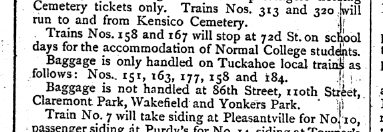
|
In the notes section of the same timetable, one train each way is noted as stopping at 72 St, not a listed station. The "Normal College", an old name for a teachers' college, is now Hunter College. Train 158 passed southbound at about 0835, and train 167 passed northbound at about 1425, so the hours may have accommodated students from Westchester County. Baggage was not handled at 86 St nor at other stations with only local trains. In those days most stations could handle baggage and express (package delivery), but these were small stations with just the space and staff for local passengers. |
|
|
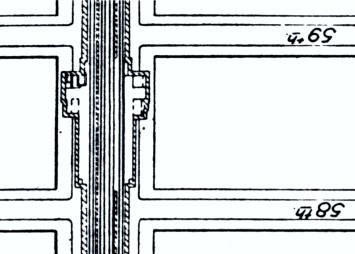
|
Above, a plan of Grand Central circa 1912 extended far enough to show the 59 St platforms. Below, this drawing published during construction was intended to show one of the sidewalk entrance buildings, on the right. The Belt Line horsecar ran in 59 St, and this view is looking uptown, showing according to the caption BEAM TUNNEL OPENINGS ON FOURTH AVENUE, 59th TO 76th STS. The entrance is therefore shown in the wrong place, a block too far north, using the plan above as reference, proving that this is an artist's conception. Unless a photograph turns up, there may be some doubt whether the sidewalk buildings were ever installed. |
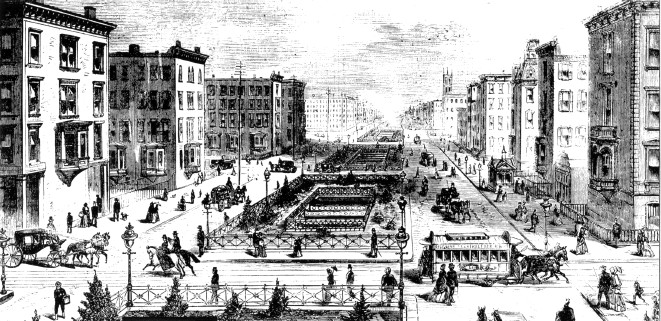
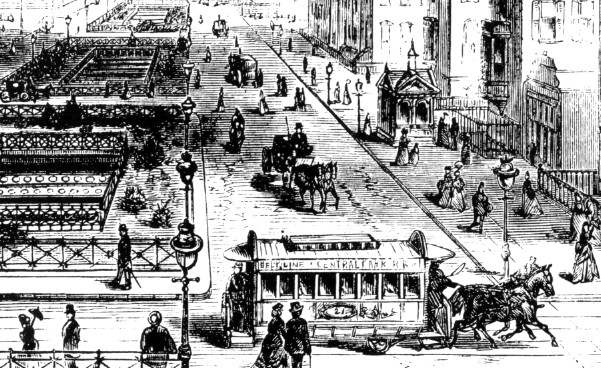
|
Scientific American, November 28, 1874. |
Track 1, northbound from Grand Central, July 2001Hudson Line trains can be relied on to run up the far left track in the afternoon rush hour, giving these views out the front door window. |
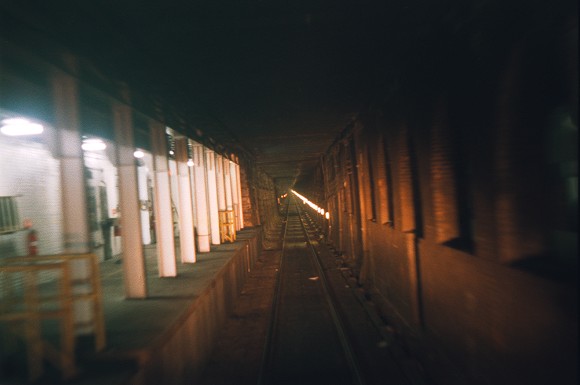
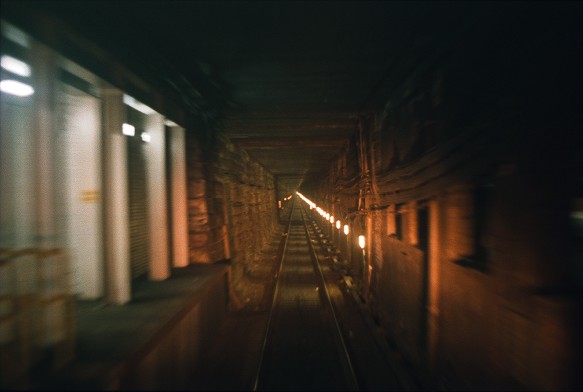
|
59 St platform (two pictures above). The silver blur at the far right may be a train running south on track 2. |
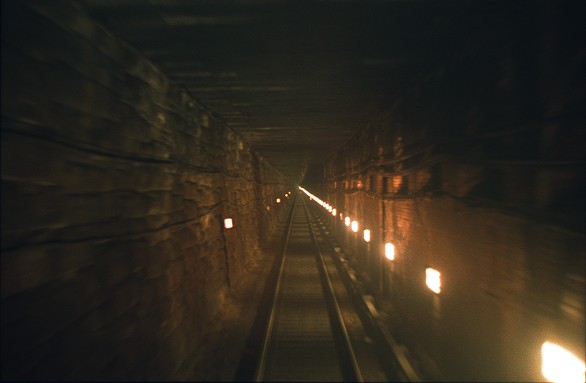
|
Beam tunnel north of 59 St. |
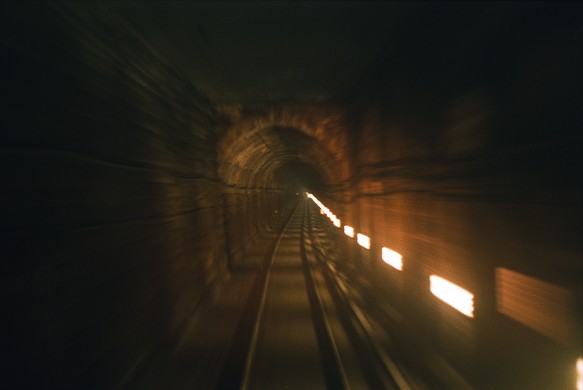
|
Beam tunnel running into brick arch tunnel, 68 St. Park Ave is perfectly straight, so what's the curve? As it approaches the brick arch section, the track has to angle away from the center tracks, and here it is about to curve back parallel to the center tracks. |
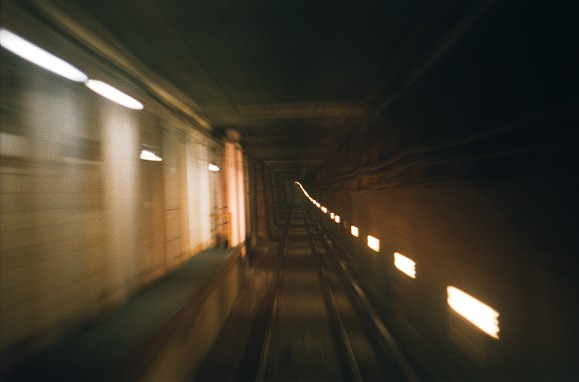
|
72 St platform. Beam tunnel ahead. |
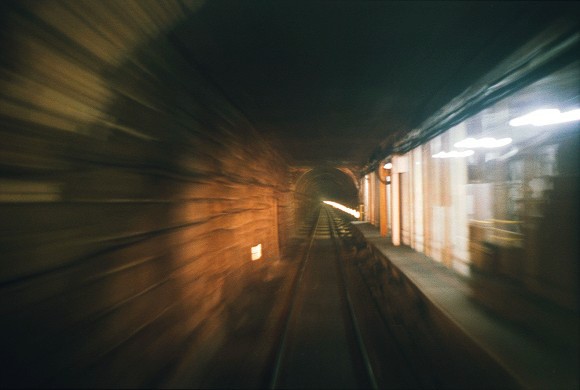
|
86 St station. Brick arch tunnel ahead. |